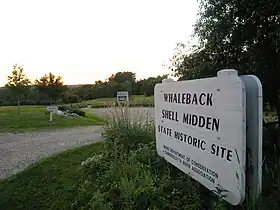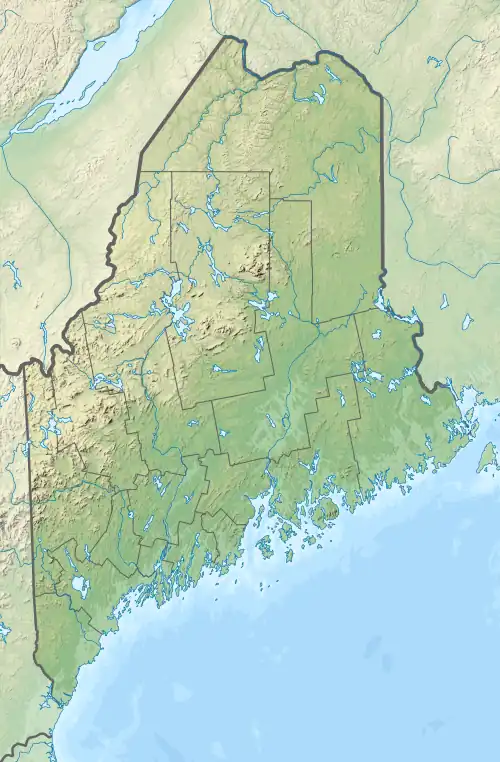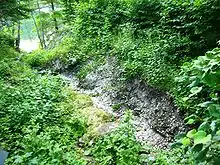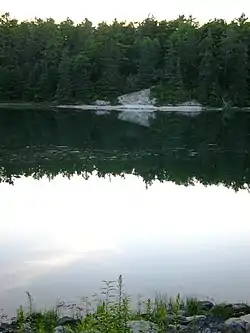Damariscotta Oyster Shell Heaps | |
 Entrance to state historic site | |
 Whaleback Shell Midden Location in Maine | |
| Location | Damariscotta, Maine |
|---|---|
| Coordinates | 44°02′31″N 69°30′47″W / 44.04194°N 69.51306°W |
| Area | 11 acres (4.5 ha) |
| Part of | Damariscotta Shell Midden Historic District (ID98001238) |
| NRHP reference No. | 69000027 |
| Significant dates | |
| Added to NRHP | December 30, 1969 |
| Designated CP | October 8, 1998 |
Whaleback Shell Midden is a shell midden, or dump, consisting primarily of oyster shells located on the east side of the Damariscotta River in Maine, United States. It is preserved as a Maine state historic site and was included as part of the Damariscotta Oyster Shell Heaps listed on the National Register of Historic Places in 1969. Other shell middens are located on the estuary in both Damariscotta and Newcastle.[1] The middens in this area were formed over about 1,000 years between 200 BC to AD 1000.
The midden originally had three main layers of shells. In the bottom two layers, individual shells were generally 5–8 inches (10–20 cm) long. These two layers are separated by a layer of soil, and the middle layer is mixed with animal bones. The top layer contains smaller shells. Artifacts unearthed lead scientists to believe that successive tribes of prehistoric people used the area. The top layer was deposited by members of the Abenaki tribes that fished in the area in the summer.[2]
Originally, the Whaleback midden was more than thirty feet deep, more than 1,650 feet (500 metres) in length, and a width varying from 1,320 to 1,650 feet (400–500 metres). It got its name from its shape. Only a small portion of this midden remains today as much of it was processed into chicken feed from 1886 to 1891 by the Massachusetts-based Damariscotta Shell and Fertilizer company, eroded by rising sea levels, or looted. Because of this, the Glidden midden, located across the river in Newcastle, is now the largest in Maine and the largest on the U.S. east coast north of Georgia.
Climate and culture
Early people in Maine were influenced by a changing climate largely shaped by glacial processes. The Late Wisconsinan Laurentide Ice Sheet (LIS) covered Maine's landscape 35,000 years ago, extending far into the ocean.[3] As the climate warmed and the ice sheet retreated, Maine's landscape underwent deglaciation from 14,500 to 11,000 BCE.[4] Due to isostatic rebound, a geological process in which the earth “rebounds” from the depression of a glacier, sea levels fluctuated immensely. At the start of the deglaciation, sea level was much higher inland;[5] the landscape at the time would have resembled modern-day northern Alaska. This promoted hunter-gatherer practices that could respond more quickly to changing climates.[6] As the glacier retreated, sea levels dropped, as low as 180 feet below what we now recognize as the coast of Maine.[5][7] Over the last few thousands of years, the sea level has slowly risen,[8] creating Maine’s large littoral zones recognizable to humans today.[9]
The Archaic Period of human culture was taking place from about 3,500 to 9,000 years ago, characterized by cultures who started to exploit marine resources.[6] There is much speculation about the transhumance of these early peoples – some hypotheses posit that settlement occupation would cause populations of people to live inland during the summer and by the coast during the winter.[10] However, there is not much archaeological evidence to suggest this, and it’s more likely that there were ethnic boundaries between groups of people and that transhumance was not occurring, meaning that populations were staying coastal or inland year-round.[10]
The Damariscotta River had been used by humans as early as 5,000 years ago based on archaeological evidence of midden sites along the banks.[5][10] When the Whaleback shell midden was most heavily populated, it could have been sustaining year-round populations of people. This leads into the question of why the site was occupied so much later than other portions of the river, a question which can be answered by looking at the regional-level geology and sea-level rise.
Geology of Damariscotta
The Damariscotta middens are notable for their size and their many oysters by a stream that has few today. The large presence is connected to coastal change, sea-level rise, and the geology of the region.[11] The midden is located between two sills, Johnny Orr and Indraft. These sills, volcanic in origin and most likely millions of years old, have influenced the salinity and temperature of the river. In fact, on the oceanside of the Johnny Orr sill, the level of the water at high tide is higher than the level on the riverside.[11]
The Eastern oyster (Crassostrea virginica) makes up a large portion of the shells located in the middens.[11][12][13] However, oysters are not present in significant populations in the river today.[12][14] This has led geologists to the understanding that at some point in time, there was a great deal of change occurring on the banks of the Damariscotta River that influenced the creation of such substantial middens. Oysters tend to like warmer, brackish waters[12] – at some point in time, salty, cold oceanic water breached the Johnny Orr sill, mixed with warmer, less salty riverine water and created an environment that could sustain oyster populations about 2400 B.P.[12][13] The water may have overtaken the sill as sea levels were slowly rising. The reason for the water coming over the sill still remains a gap in the story of the Damariscotta River.
Though oysters do still exist buried underneath silt near the middens,[12] significant oyster populations no longer exist within the river due to four possible reasons: 1) predator introduction,[13][14] 2) suffocation from the dust of the sawmill upshore,[11][14] 3) increasingly saline environments,[11] and 4) lower water temperatures.[11] In all likelihood, it was probably a combination of all of these factors.[11][13] Damariscotta is just another example of how changes in the climate have influenced human realities.
Threats to middens
Over 2,000 other middens exist along the Maine coast but many of their locations are undisclosed due to fear of looting. Unfortunately, looting is not the only threat they face. As sea levels rise due to climate change, middens like Whaleback have been swept away to the ocean. The thousands of other middens can offer equally compelling evidence of early-Maine habitation, geology, biology, and many more important disciplines. For example, one midden site has helped scientists piece together that at one point, there was a great deal of swordfish being caught within the Gulf of Maine despite being a deep-sea fish that could prove difficult to catch with dugouts.[15] This challenges our understanding of early maritime technology. Though the need to conduct studies on these studies should be done, it is important to note that they should be carried out with the approval of the landowner on whose property the middens are located, as well as with the associated tribes. To start the process of either studying a shell midden or formally recognizing a midden, interested parties can become involved in the University of Maine ‘Midden Minders’ project[16] which seeks to catalog the various sites along the coast and document the impact of shoreline change.
State historic site
The area around the remains of the Whaleback is a Maine state historic site, first opened for a full season in 2005, with some historical displays and a hiking trail.[17][18]
Oyster culturing
By 1875 oysters that were once abundant were no longer native to New England waters.[19] Wild populations have been established in recent years by the spawn of aquaculture oysters.[20]
Gallery
 A gully running through the midden to the Damariscotta River.
A gully running through the midden to the Damariscotta River. Closeup of one of the thousand year old oyster shells.
Closeup of one of the thousand year old oyster shells. The Glidden Shell Midden is located immediately across the Damariscotta River.
The Glidden Shell Midden is located immediately across the Damariscotta River.
See also
References
- ↑ "Damariscotta Shell Middens". Davistown Museum. Retrieved December 13, 2015. A compilation of articles and annotations on shell middens in the area.
- ↑ Maine League of Historical Societies and Museums (1970). Doris A. Isaacson (ed.). Maine: A Guide 'Down East'. Rockland, Me.: Courier-Gazette, Inc. p. 258.
- ↑ Braun, Duane D. Guide to the geology of Mount Desert Island and Acadia National Park. Braun, Ruth (Geology instructor). Berkeley, California. ISBN 978-1-62317-053-0. OCLC 922836428.
- ↑ Borns, Harold W. Jr.; Doner, Lisa A.; Dorion, Christopher C.; Jacobson, George L. Jr.; Kaplan, Michael R.; Kreutz, Karl J.; Lowell, Thomas V.; Thompson, Woodrow B.; and Weddle, Thomas K., "The Deglaciation of Maine, USA" (2004). Earth Science Faculty Scholarship. 276.
- 1 2 3 Kelly, J., Belknap, D., Claesson, S., 2010, Drowned coastal deposits with associated archaeological remains from a sea-level “slowstand”: Northwestern Gulf of Maine, USA, Department of Earth Sciences, University of Maine, Orono, Maine
- 1 2 "Maine Archaeological Timeline | Research | Abbe Museum". archive.abbemuseum.org. Retrieved June 2, 2020.
- ↑ NOAA Coastal Ocean Program Regional Synthesis Series. U.S. Department of Commerce, National Oceanic and Atmospheric Administration, NOAA Coastal Ocean Program Office. 1992.
- ↑ Kelley, Dickson and Belknap. "Maine's History of Sea-Level Changes" (1996). Maine Geological Survey. https://www.maine.gov/dacf/mgs/explore/marine/facts/sealevel.pdf
- ↑ Spiess, Aruther E. (2017) “People of the Clam: Shellfish and Diet in Coastal Maine Late Archaic and Ceramic Period Sites”. Journal of the North Atlantic, 10(sp10): 105-112. Eagle Hill Institute.
- 1 2 3 Sanger, David. (1996) “Testing the Models: Hunter-Gatherer Use of Space in the Gulf of Maine, USA”. World Archaeology, 27(3). Taylor & Francis, Ltd.
- 1 2 3 4 5 6 7 Sanger, David, 1936- (1985). Sea-level rise and archaeology in the Damariscotta River. Maine Geological Survey, Dept. of Conservation. OCLC 26127580.
- 1 2 3 4 5 Sanger, David, and Douglas C. Kellogg. Prehistoric Archaeology and Evidence of Coastal Subsidence on the Coast of Maine. 1989, pp. 107–126.
- 1 2 3 4 Sanger, David, and Mary Jo Sanger. “The Damariscotta Oyster Shell Heaps.” Northeastern Naturalist, vol. 4, no. 2, 1997, pp. 93–102. JSTOR, doi:10.2307/3858407.
- 1 2 3 Weddle, Tom. “Sea-Level Rise and the Damariscotta River Oyster Shell Middens” Maine Geological Survey. 2011.
- ↑ "Turner Farm Midden Analysis". https://link.springer.com/content/pdf/bbm%3A978-0-585-27574-1%2F1.pdf
- ↑ "Welcome - Maine Midden Minders - University of Maine". Maine Midden Minders. Retrieved June 2, 2020.
- ↑ "Whaleback Shell Midden". Department of Agriculture, Conservation and Forestry. Retrieved December 13, 2015.
- ↑ Hoey, Dennis (June 27, 2005). "Midden comes out of its shell". Outdoors, MaineToday.com. Blethen Maine Newspapers, Inc. Archived from the original on May 15, 2006. Retrieved October 11, 2010.
- ↑ Drake, Samuel Adams (1875). Nooks and Corners of the New England Coast. New York: Harper & Brothers. Retrieved December 13, 2015.
- ↑ "Growing Areas". Glidden Point Oyster Sea Farm. Retrieved December 13, 2015.
External links
- Whaleback Shell Midden Department of Agriculture, Conservation and Forestry